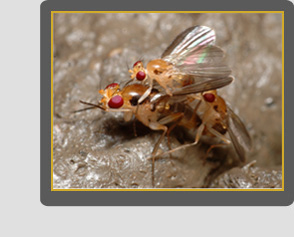| |

Characteristics
Sobarocephala Czerny is the largest clusiid genus, with well over 200 recognized species. Most of these species occur in the Neotropics, but 17 species are found in the Nearctic (Lonsdale & Marshall, 2007c), two species are known from Japan (Sueyoshi, 2006), and at least a dozen described and undescribed species occur in the Afrotropical, Australian and Oriental Regions.
Sobarocephala is an incredibly diverse genus that can be very difficult to characterize because of frequent character reversal and homoplasy. As a result, a combination of characters is usually necessary to diagnose the genus: externally, vein R11 is bare dorsally, the anterior fronto-orbital bristle is inclinate, the presutural intra-alar bristle is (almost always) absent, cell bm is often open (ie. confluent with cell dm; also found in Procerosoma), and the mid tibia always has a dorsal preapical bristle. Most species are yellow with a variable brown pattern, but some species are predominantly black and a number have lost nearly all of their pigment.
The only synapomorphies defining Sobarocephala are male genitalic: the distiphallus has an additional shield-like sclerite at its base, and the lateral lobe of the distiphallus has an accessory 'thumb-like' extension (Lonsdale & Marshall, 2006a). The thumb-like structure is frequently reduced or absent, but the basal shield is almost always present.
Sobarocephala most closely resembles the sobarocephaline genera Chaetoclusia and Procerosoma, but vein R1 of Chaetoclusia is always setulose, and Procerosoma is missing several cephalic bristles, some notal bristles and all dorsal preapical tibial bristles. The relatively common Heteromeringia is most easily confused with Sobarocephala, but Heteromeringia has a very long double-ribbed phallus, one minute lateral scutellar bristle, no dorsal preapical tibial bristles, and only a few Neotropical Sobarocephala are as darkly pigmented.
Relationships
Sobarocephala is divided into a number of species groups, almost entirely on the basis of male genitalic characters (Lonsdale & Marshall, in manuscript). Only one species group can be reliably identified using an external synapomorphy, the S. flaviseta group, which is defined (in part) by a frons that strongly narrows towards the back of the head. This is the largest of the nine groups, and almost every species is characterized by either a densely plumose arista or ivory-white patches on the notum (Lonsdale & Marshall in manuscript). Most members of the group containing S. ruebsaameni are encountered with relative frequency in Central America, and are characterized by spotted wings easily seen with the naked eye.
Biology
Little is known of the biology of Sobarocephala, although adults of most North American species are commonly found around bare logs or dead trees under partial shade in moist, predominantly deciduous woodland (Malloch, 1918; Sabrosky & Steyskal, 1974). In Ontario, S. atricornis Sabrosky & Steyskal has been collected around Impatiens L., sedges and ferns. Sobarocephala flava has been collected in association with or amongst Poa L., Agrostis L., Phleum L., Festuca L. and Juncus L., and S. latifacies has been collected by sweep-netting in Impatiens, Clematis L., Rubus L. and grasses (Lonsdale & Marshall, 2007c). In Saskatchewan, S. lachnosternum Melander & Argo has been caught in grasses in birch/poplar woodlands. In the Neotropical Region, specimens have often been observed on dung, especially on logs and around damp, mossy areas near water. Adults have also been known to feed on nectar, sap and decaying vegetation (Malloch, 1918).
North American species:
- Sobarocephala affinis
- Sobarocephala atricornis
- Sobarocephala atrifacies
- Sobarocephala cruciger
- Sobarocephala dreisbachi
- Sobarocephala flava
- Sobarocephala flaviseta
- Sobarocephala interrupta
- Sobarocephala lachnosternum
- Sobarocephala latifacies
- Sobarocephala latifrons
- Sobarocephala muesebecki
- Sobarocephala pengellyi
- Sobarocephala quadrimaculata
- Sobarocephala setipes
- Sobarocephala texensis
- Sobarocephala wirthi
|
|
 |